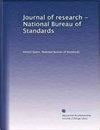Fluorescence Spectrometric Determination of Nonfluorescent Compounds via Molecular Fragmentation
Journal of research of the National Bureau of Standards
Pub Date : 1988-05-01
DOI:10.6028/jres.093.108
引用次数: 1
Abstract
Molecular fluorescence spectrometry offers several important analytical advantages, including (a) achievement of very low limits of detection for intensely fluorescent analytes, (b) applicability to determine individual constituents of multicomponent samples without prior separation, (c) applicability to remote detection of analytes via fiber optic and/or laser probes, and (d) the high information content of luminescence measurements (excitation and emission spectra, decay times, polarization). A principal shortcoming of fluorescence spectrometry is the fact that most organic and inorganic molecules exhibit low luminescence quantum yields and thus cannot be detected by fluorometry without first being converted to fluorescent derivatives. Accordingly, many procedures for derivatizing nonfluorescent analytes to form luminescent products have been devised. Our work takes a somewhat different approach to fluorometric detection of nonfluorescent molecules. We exploit the fact that many small molecular fragments are intensely luminescent, including such common species as NH, OH, CN, CH, PO, and SH, as well as many atoms. Fluorescent fragments can be produced from virtually any nonfluorescent molecule. For analytical purposes, the key is to perform the fragmentation in a sufficiently reproducible manner that the fluorescence intensity of a fragment species can be related to the concentration of parent molecule present in the initial sample. We presently perform molecular fragmentations in the gas phase, to avoid "cage effects" which often decrease the efficiencies of fragmentation processes in liquid or solid media to unacceptably low levels. From among the large number of possible techniques for molecular fragmentation, we have chosen laser photolysis (LP) and electron impact (El) as the most promising methods. In LP experiments, gaseous samples are fragmented by either the beam from an excimer laser (193 nm) or tunable radiation from an excimerpumped dye laser. In El methods, molecules are fragmented by 100-eV electrons from a conventional heated-filament electron gun. A certain fraction of fragment species are produced in electronically excited states and emit directly. If needed, a "probe" laser can be used to excite luminescence from fragments formed in their ground electronic states by LP or El. Vacuum systems comparable in design and performance to those found in conventional mass spectrometers are usually used, though LP fragmentations can also in principle be applied directly to remote atmospheric sensing. Conventional fluorescence measurement and signal-processing techniques are used. We will describe studies of the analytical characteristics (limits of detection, linear dynamic range, precision) for LP and El fragmentation-fluorometric detection of a variety of nonfluorescent organic and organometallic compounds. The possibility of using low-temperature techniques (matrix isolation or supersonic expansion) to increase the selectivity of such measurements will be described. The complementarity of these measurements to mass spectrometry will be emphasized (most of the intensely emissive fragment species are neutrals, whereas ionic fragments are detected in mass spectrometry).分子碎片化荧光光谱法测定非荧光化合物
分子荧光光谱法提供了几个重要的分析优势,包括(a)对强烈荧光分析物的检测限非常低,(b)适用于在没有事先分离的情况下确定多组分样品的单个成分,(c)适用于通过光纤和/或激光探针远程检测分析物,以及(d)发光测量的高信息含量(激发和发射光谱,衰减时间,极化)。荧光光谱法的一个主要缺点是,大多数有机和无机分子的发光量子产率很低,因此如果不首先转化为荧光衍生物,就不能用荧光法检测。因此,已经设计了许多将非荧光分析物衍生成发光产物的方法。我们的工作采用了一种不同的方法对非荧光分子进行荧光检测。我们利用了这样一个事实,即许多小分子片段是强烈发光的,包括像NH、OH、CN、CH、PO和SH这样的常见物种,以及许多原子。几乎任何非荧光分子都可以产生荧光片段。为了分析的目的,关键是要以一种足够可重复的方式进行碎片化,使碎片物种的荧光强度可以与初始样品中存在的亲本分子的浓度相关。我们目前在气相中进行分子破碎,以避免“笼状效应”,这种效应通常会使液体或固体介质中破碎过程的效率降低到不可接受的低水平。在众多可能的分子断裂技术中,我们选择了激光光解(LP)和电子撞击(El)作为最有前途的方法。在LP实验中,气体样品被准分子激光器(193 nm)的光束或准分子泵浦染料激光器的可调谐辐射破碎。在El方法中,分子被来自传统加热丝电子枪的100 ev电子破碎。在电子激发态中产生一定比例的碎片物种并直接发射。如果需要,“探测”激光可以用来激发LP或El在其基电子状态下形成的碎片的发光。通常使用在设计和性能上与传统质谱仪相当的真空系统,尽管LP碎片原则上也可以直接应用于遥感大气。使用传统的荧光测量和信号处理技术。我们将描述各种非荧光有机和有机金属化合物的LP和El碎片荧光检测的分析特性(检测限,线性动态范围,精度)的研究。使用低温技术(矩阵隔离或超音速膨胀)来增加这种测量的选择性的可能性将被描述。这些测量与质谱的互补性将被强调(大多数强烈发射的碎片物种是中性的,而离子碎片在质谱中被检测到)。
本文章由计算机程序翻译,如有差异,请以英文原文为准。
求助全文
约1分钟内获得全文
求助全文

 求助内容:
求助内容: 应助结果提醒方式:
应助结果提醒方式:


